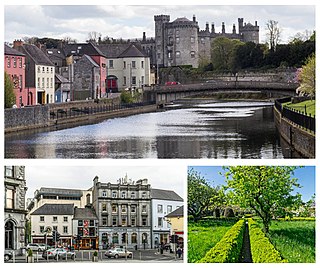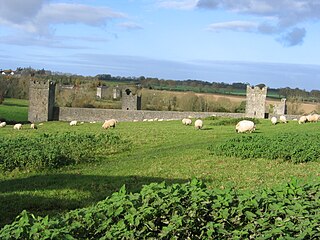Related Research Articles

Kilkenny is a city in County Kilkenny, Ireland. It is located in the South-East Region and in the province of Leinster. It is built on both banks of the River Nore. The 2016 census gave the population of Kilkenny as 26,512.

Flying ointment is a hallucinogenic ointment said to have been used by witches in the practice of European witchcraft from at least as far back as the Early Modern period, when detailed recipes for such preparations were first recorded and when their usage spread to colonial North America.
Dame Alice Kyteler was the first recorded person condemned for witchcraft in Ireland. She fled the country to either England or Flanders, and there is no record of her after her escape from persecution. Her servant Petronilla de Meath was flogged and burned to death at the stake on 3 November 1324, after being tortured and confessing to the heretical crimes she, Kyteler, and Kyteler's followers were alleged to have committed.
Petronilla de Meath was the maidservant of Dame Alice Kyteler, a Hiberno-Norman noblewoman who lived in Ireland in what is now County Kilkenny. After the death of Kyteler's fourth husband, Kyteler was accused of practicing witchcraft and Petronilla was charged with being one of her accomplices. Petronilla was tortured and forced to proclaim that she and Kyteler were guilty of witchcraft. Kyteler fled to save her life, and Petronilla was then flogged and eventually burnt at the stake on 3 November 1324, in Kilkenny. Hers was the first known case in Ireland or Great Britain of death by fire for the crime of heresy.

Kells Priory is one of the largest medieval monuments in Ireland. The Augustine priory is situated alongside King's River beside the village of Kells in the townland of Rathduff (Madden), about 15 km south of the medieval city of Kilkenny. The priory is a National Monument and is in the guardianship of the Office of Public Works. One of its most notable features is a collection of medieval tower houses spaced at intervals along and within walls which enclose a site of just over 3 acres (12,000 m2). These give the priory the appearance more of a fortress than of a place of worship and from them comes its local name of "Seven Castles".
Events from the year 1347 in Ireland.
John D'arcy, 1st Baron D'arcy de Knayth was an English peer. He was created 1st Baron Darcy in 1317.
Alexander de Bicknor was an official in the Plantagenet kingdom under Edward I of England, Edward II of England, and Edward III of England. Best known to history as the Archbishop of Dublin from 1317 until his death in 1349, his career involved extensive diplomatic missions for the King and the holding of numerous civil and ecclesiastical offices in Ireland, including Lord Treasurer of Ireland (1307–1309) and Lord Chancellor of Ireland.

Calverstown is a small village in County Kildare, Ireland. It lies 6 km (3.7 mi) south of the town of Kilcullen and about 16 km (9.9 mi) from each of the towns of Athy, Kildare, Naas and Newbridge. It is an old settlement located close to the archaeological sites of Dún Ailinne and Old Kilcullen. The village has a stream running through it with another to the south. As of the 2016 census, Calverstown had a population of 699.
Events from the year 1324 in Ireland.

St Canice's Cathedral, also known as Kilkenny Cathedral, is a cathedral of the Church of Ireland in Kilkenny city, Ireland. It is in the ecclesiastical province of Dublin. Previously the cathedral of the Diocese of Ossory, it is now one of six cathedrals in the United Dioceses of Cashel and Ossory.

The history of Kilkenny began with an early sixth-century ecclesiastical foundation, this relates to a church built in honour of St. Canice, now St. Canice's Cathedral and was a major monastic centre from at least the eighth century. The Annals of the Four Masters recorded the first reference Cill Chainnigh in 1085. Prehistoric activity has been recorded suggesting intermittent settlement activity in the area in the Mesolithic and Bronze Age. Information on the history of Kilkenny can be found from newspapers, photographs, letters, drawings, manuscripts and archaeology. Kilkenny is documented in manuscripts from the 13th century onwards and one of the most important of these is Liber Primus Kilkenniensis.
Roger Utlagh, or Roger Outlawe was a leading Irish cleric, judge and statesman of the fourteenth century who was Prior of Kilmainham, and held the office of Lord Chancellor of Ireland. He was the brother-in-law of the celebrated Witch of Kilkenny, Alice Kyteler, and is mainly remembered today for his efforts to shield her from prosecution, and subsequently enabling her to escape punishment, during the Kilkenny Witch Trials of 1324.
Walter de Islip, or de Istlep was an English-born cleric, statesman, and judge in fourteenth-century Ireland. He was the first Chief Baron of the Irish Exchequer; he also held the offices of Treasurer of Ireland, Chief Escheator, and Custos Rotulorum of Kilkenny. He was a noted pluralist, who held numerous clerical benefices. His career was damaged by accusations of corruption and maladministration. He played an important role in the celebrated Kilkenny Witchcraft Trials of 1324.
John de St Paul, also known as John de St. Pol, John de Owston and John de Ouston, was an English-born cleric and judge of the fourteenth century. He was Archbishop of Dublin 1349–62 and Lord Chancellor of Ireland 1350–56. He had previously been Master of the Rolls in England 1337–40. Apart from a brief period of disgrace in 1340, he enjoyed the confidence of King Edward III. He was described as a zealous supporter of English rule in Ireland, but also as a pragmatic statesman who was willing to conciliate the Anglo-Irish ruling class. He did much to enlarge and beautify Christ Church, Dublin, although virtually no trace of his improvements survive, as they were destroyed by the Victorian rebuilding of the cathedral.
William de Rodyard, de Rodiard, or de Rudyard was an English-born judge and cleric in fourteenth-century Ireland. He held office as Chief Justice of the Irish Common Pleas. He was also Dean of St Patrick's Cathedral, and briefly Deputy Lord Treasurer of Ireland. He was the first Chancellor of the Medieval University of Dublin.
Robert le Poer was an Irish judge and Crown official who held the offices of Lord High Treasurer of Ireland and Chief Baron of the Irish Exchequer.
The Red Book of Ossory is a medieval manuscript produced in Kilkenny, Ireland, and kept in St Canice's Cathedral. The manuscript contains a number of texts in Latin and in Anglo-Norman. The sixth gathering of the MS contains the Proverbes de bon enseignement by Nicholas Bozon. The Latin religious lyrics in the manuscript were intended to replace more secular songs in the vernacular, and were composed by Richard de Ledrede, Bishop of Ossory.
The Seneschal of Gascony was an officer carrying out and managing the domestic affairs of the lord of the Duchy of Gascony. During the course of the twelfth century, the seneschalship, also became an office of military command. After 1360, the officer was the Seneschal of Aquitaine. There was an office above the seneschalcy, the Lieutenancy of the Duchy of Aquitaine, but it was filled only intermittently.
John de Ponz, also called John de Ponte, John Savan, or John of Bridgwater (c.1248–1307) was an English-born administrator, lawyer and judge in the reign of King Edward I. He served in the Royal Household in England for several years before moving to Ireland, where he practised in the Royal Courts as the King's Serjeant-at-law (Ireland). He later served as a justice in eyre, and then as a justice of the Court of Common Pleas (Ireland). He was a gifted lawyer, but as a judge was accused of acting unjustly. A case he heard in Kilkenny in 1302 can be seen as a precursor of the Kilkenny Witchcraft Trials of 1324, and involved several of the main actors in the Trials.
References
- 1 2 Neary 1984, p. 273.
- ↑ Greene, Richard L. (1952). "'The Maid of the Moor' in the Red Book of Ossory". Speculum . 27 (4): 504–506. doi:10.2307/2850478. JSTOR 2850478. S2CID 162229732.
- ↑ Williams, Bernadette (1994). "The Sorcery Trial of Alice Kyteler". History Ireland . Retrieved 12 June 2022.
- 1 2 Otway-Ruthven, A. J. (1993) [1968]. A History of Medieval Ireland (2nd ed.). New York: Barnes and Noble. p. 245. ISBN 1566192161.